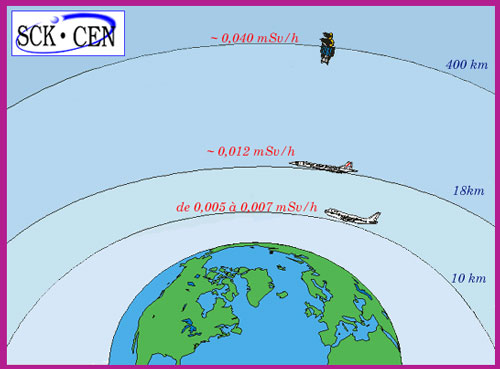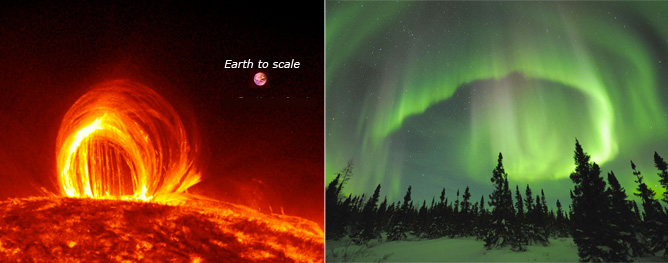A stronger exposition near the poles

The atmospheric shield
The layers of air in the atmosphere give a protection against cosmic rays which decrease with altitude and depends on the route taken. For commercial aircraft flying at an altitude of 10km the dose received varies from 0.005 mSv to 0.007 mSv per hour depending on whether the aeroplanes do or do not pass through the Poles. At 18km the dose is approximately doubled. For an astronaut in a space station at 400km of altitude the dose rate reaches 0.040 mSv per hour. Two and a half days in orbit are enough to be exposed to a year of natural radioactivity on earth (2,4 mSv)
© SCK.CEN (source L.de Saint-Georges).
The shortest path between New York and Hong Kong goes through the North Pole. In March 2001, two American airline companies opened up a transpolar route, linking these two towns. A Chinese company was also due to follow. The cabin crews and passengers using these polar routes were exposed to additional radiation, the American press echoing the concerns of scientists as well as pilots, stewards and stewardesses.
The importance of the Poles is that the Earth acts as a magnet. The magnetic field which surrounds it deflects the cosmic rays bombarding it. This magnetic shield adds to the layers of the atmosphere protecting us from radiations, except for the two defects in its armour at the North and South Poles. A traveller taking the polar route to go from New York to Hong Kong, will for this reason be exposed to a dose of 0,100 millisievert (mSv), three times stronger than the dose of a passenger on a flight from Los Angeles to Tokyo, which only lasts a little less long.
Cosmic rays come maily from the sun, in other terms from a rather close neighbourhood of the Earth at the scale of the Universe. The doses received therefore depend on the activity of the sun and its 11year cycle. The sun exhibits periods of disruption which like earthquakes are rated according to their magnitude. Flying over the Pole during storms of high magnitude should be avoided. A plane taking such a route during the strongest storm registered would have exposed passengers to ten times the 0, 100 mSv of a normal flight.

Solar eruptions and northern ligths (auroras borealis)
Solar eruptions are gigantic cataclysms that eject a large number of high energy cosmic particles in space.The shield due to the magnetic field surrounding the earth prevents these particles from reaching its surface except in regions close to the poles. During solar eruptions, the showers of cosmic particles reaching regions like Scandinavia are at the origin of magnificent aurora borealis. Air flights should avoid those strong radiation episodes that are predictable.
© NASA
Airlines which operate these routes have taken measures. They change their routes in the case of a solar storm. The American Spatial Centre keeps a close control on the activity of the sun. It produces predictions for the coming week, calculates the activity for the following 24hours and sends alerts in the case of a powerful eruption.
Any traveller has now free access to this information, thanks to the internet. A website allows him to calculate the millisieverts received from one airport to another. The calculation does not take into account solar eruptions, whose influence can be ignored outside the polar routes.